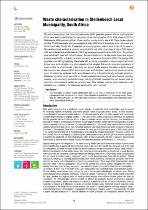| dc.contributor.author | Nell, Charlotte M. | |
| dc.contributor.author | Schenck, Catherina | |
| dc.contributor.author | de Waal, Jan | |
| dc.date.accessioned | 2022-09-28T12:54:07Z | |
| dc.date.available | 2022-09-28T12:54:07Z | |
| dc.date.issued | 2022 | |
| dc.identifier.citation | Nell, C. M. (et al. (2022). Waste characterisation in Stellenbosch Local Municipality, South Africa. South African Journal of Science, 118, #12795. https://doi.org/10.17159/sajs.2022/12795 | en_US |
| dc.identifier.issn | 1996-7489 | |
| dc.identifier.uri | https://doi.org/10.17159/sajs.2022/12795 | |
| dc.identifier.uri | http://hdl.handle.net/10566/7980 | |
| dc.description.abstract | This article demonstrates how household solid waste (HSW) generation patterns differ in neighbourhoods of the same town by determining the composition of the residual portion of the HSW stream in 2017 in Stellenbosch. HSW was collected from 10 pre-identified suburbs out of a total of 48. These chosen suburbs and their 17 830 households were representative of all the HSW from all households in the catchment area of the Devon Valley Landfill Site. A separation at source programme was in place in nine of the suburbs.The confidence level and level of precision were set at 95% and ±8%, respectively. A total of 1543 bags of HSW were collected with a total mass of 5748.01 kg and an uncompacted volume of 84.87 m3. The samples were sorted into 7 main and 18 final fractions. | en_US |
| dc.language.iso | en | en_US |
| dc.publisher | Academy of Science of South Africa | en_US |
| dc.subject | Waste characterisation studies | en_US |
| dc.subject | Waste data | en_US |
| dc.subject | Solid waste | en_US |
| dc.subject | Stellenbosch Local Municipality | en_US |
| dc.subject | Recycle | en_US |
| dc.title | Waste characterisation in Stellenbosch Local Municipality, South Africa | en_US |
| dc.type | Article | en_US |

